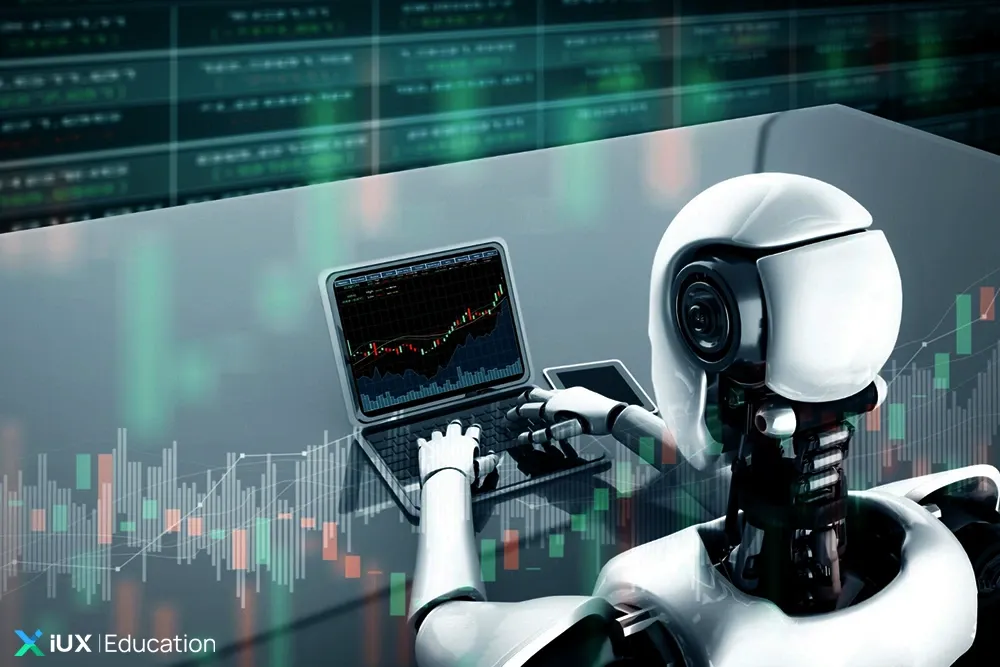CFDs are complex instruments and come with a high risk of losing money rapidly due to leverage. 76% of retail investor accounts lose money when trading CFDs with this provider. You should consider whether you understand how CFDs work and whether you can afford to take the high risk of losing your money.
CFDs are complex instruments and come with a high risk of losing money rapidly due to leverage. 76% of retail investor accounts lose money when trading CFDs with this provider. You should consider whether you understand how CFDs work and whether you can afford to take the high risk of losing your money.

How to Use AI in Stock Trading Without Making Costly Mistakes
Using AI in Stock Trading: Opportunities and Risks Every Investor Should Know
Artificial intelligence is rapidly transforming the landscape of investing. More and more investors are turning to AI for stock trading, drawn by its ability to analyze vast amounts of data and make fast, accurate decisions.
However, the convenience and impressive efficiency of AI also come with hidden risks. This article offers a well-rounded look at how AI is being used in stock trading, highlights key risks to watch out for, and provides guidance on how to use this technology safely—so investors can make the most of its potential in a responsible and informed way.
The Rise of AI in Stock Trading

Using artificial intelligence in stock trading is no longer a novelty for today’s investors. However, understanding how these systems work is essential.
Most AI systems used in trading rely on machine learning and advanced algorithms capable of processing massive amounts of data in a short period—something human traders struggle to do. This data includes stock price trends, economic news, technical indicators, and other factors that may influence the market. The system then analyzes this information and generates automated buy or sell signals.
One clear advantage is the reduced burden of manual data analysis, along with decision-making that’s free from emotional bias. That said, it’s important to remember that AI is not a tool that delivers 100% accurate results in every situation. 1
Read more about AI and the world of investing
The Hidden Risks of Using AI in Stock Trading
While AI can enhance speed and eliminate emotionally driven decisions, it also comes with limitations and risks that investors need to evaluate carefully, such as:
-
Incomplete or Biased Data
The effectiveness of AI depends heavily on the quality of the data it receives. If the input data is incomplete, biased, or not reflective of current market conditions, the system may generate poor or misleading recommendations. For example, relying solely on historical market data that doesn’t align with today’s environment could lead to inaccurate forecasts. Additionally, some financial information—such as company reports or real-time updates—may not be fully accessible to the AI system, limiting its accuracy.
-
Over-Reliance on AI Analysis
A common misconception is that AI can manage an investment portfolio entirely on its own. In reality, investors still play a crucial role in setting strategies, monitoring performance, and configuring investment parameters. Leaving everything to automated systems—especially during periods of high market volatility—can result in unexpected losses.
How to Use AI in Stock Trading Safely
-
Structured Risk Management
Setting clear risk limits is essential. This includes using tools like stop-loss orders to cap potential losses, take-profit levels to secure gains, and limits on the amount allocated to each trade. These controls help ensure the AI system stays within your defined risk parameters and doesn’t make trades that exceed your comfort zone.
-
Regular Monitoring and Performance Review
Investors should avoid a completely hands-off approach when using AI. Ongoing performance reviews are key, including backtesting results, analyzing how the system reacts in both stable and volatile market conditions, and identifying any weaknesses in its logic. This helps gauge the reliability and resilience of the AI model over time.
-
Careful Research and Tool Selection
Before deploying AI tools in live trading, it’s important to thoroughly understand the platform you’re using. This includes examining the transparency of the algorithm, how data is handled, the background of the developers, and conducting simulations or demo runs before committing real capital. Choosing the wrong tool or rushing in without research could lead to preventable losses.
Using AI as an investment assistant is becoming increasingly essential in the future. Choosing the right platform is just as important.
At IUX, we support investors with user-friendly chart analysis tools, portfolio management features, and real-time asset pricing data from global markets.
Sign up and start investing with IUX today with tools designed for investors at every level.

Key Considerations Before Using AI in Live Trading
Before applying AI to real-world investing, it’s important for investors to understand how the system works, as well as its limitations—especially when it comes to data access. AI tools may not have real-time updates or full access to certain financial information, such as live market conditions or up-to-date earnings reports. In some cases, these gaps can impact the accuracy of its recommendations.
In addition, investors should have a solid understanding of stock markets and basic investment analysis. This knowledge is essential for reviewing and assessing whether the insights generated by AI are reasonable and aligned with sound investment principles.
In the End, AI Is a Tool—Not a Decision-Maker
Successful investing isn’t just about using cutting-edge technology. It’s about striking the right balance between technological advancement and human insight.
AI is a powerful assistant when it comes to gathering and analyzing large volumes of data, as well as handling tasks that require speed and repetition. But ultimately, investment decisions should rest in the hands of investors who truly understand both the market and themselves.
When used mindfully—with a clear strategy and proper risk management—AI becomes more than just a tool. It becomes a trusted support system that enhances confidence and safety in long-term trading. By recognizing AI’s limitations and leveraging its strengths, investors can move forward with greater clarity in an ever-evolving market environment.
Articles you may be interested in: The role of AI and automation in trading
💡FAQs
Q: Can AI guarantee accurate predictions in stock trading?
A: No. AI can process data quickly, but it can’t foresee sudden events or market shocks. It should support decisions, not replace them.
Q: Is it safe for beginners to use AI tools for trading?
A: Yes—if they understand basic market concepts and monitor performance. AI helps simplify analysis, but beginners shouldn’t rely on it fully.
Q: What should investors check before using AI for live trading?
A: Review the platform’s data sources, algorithm transparency, and risk controls. Backtest first and ensure it fits your risk tolerance.
NOTE: This article is intended for educational purposes only and does not constitute investment advice in any form. The content provided here is solely to inform readers about trading and trends in AI technology. Investors should conduct their own research and exercise discretion before making any investment decisions.
Source 1




